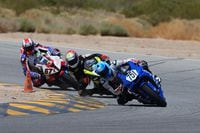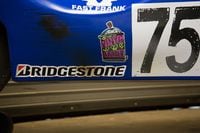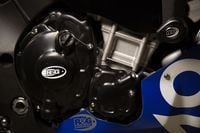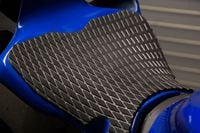This product test and update is part of a running story of Zack's 2015 R1 Long-Term Test, which he prepped for the track and then raced. To read more about the project, click here.
When I set out to turn this 2015 R1 into a race bike I set some goals for myself, the most prominent being to either win a race or go fast enough that I felt I reached my personal limit and wasn’t being held back by the bike. Secretly, as arbitrary as it sounds, I wanted to break the 1-minute 50-second barrier at the Chuckwalla Valley Raceway (my previous best was somewhere in the 1:52 bracket, on a stock literbike). The other requisite was to go racing as simply and economically as possible.
As discussed in a previous update (click here for Zack's club racing update), I added Hotbodies Racing bodywork, R&G Racing crash protection, and Bridgestone R10 race rubber. The result was a 3rd place finish and a lap time of 1:51.9. Good, not great. I struggled with overheating the DOT-spec R10 race tire, but mostly just calibrating myself to the cognitive pace of racing a 1,000cc superstock machine. Line selection is paramount and there's no time to rest. I knew I had more to give, and the bike was ready.
A couple of months later, and I set out once again to Chuckwalla. This time armed with Motorcyclist stickers splashed across the unpainted bodywork, Bridgestone V02 slick race rubber and, perhaps most important of all, "real" printed race numbers from our friends at Vinyl Disorder (vinyldisorder.com). That's gotta be worth at least a few tenths! Jokes aside, the slicks were immediately an improvement—quicker transitions, more feedback, and no matter how much power I fed to the rear tire I couldn't overheat it (click here to read about how the slicks compare to DOT street-legal race rubber). The result this time? The R1 achieved a victory in Open Supersport and a lap time of 1:49.1. As a reminder: this is an R1 with a stock ECU, stock pipe, and stock suspension that hasn't even been adjusted away from owner's-manual settings.
With that outcome, some things should be clear. One, if you can slap slicks on it and get within a couple of seconds of the lap record, it makes sense that people complain about the R1 being too stiff as a street bike! Hell, my coworker Ari even said he thought it was too stiff as a race bike when he tried it. And two, this proves once and for all that the R1 is a showroom-ready track weapon. The V02 slicks ($400/set; bridgestone.com) are not cheap, and it's an investment in time and money to race-prep any bike. But, it also means my research is complete. I need not explore the boundaries of the R1's track potential any more. Ehhh, actually, one more weekend won't hurt, right?










/cloudfront-us-east-1.images.arcpublishing.com/octane/GCXH45RTJ6IAMBGL2RKT6XRWKY.jpg)




/cloudfront-us-east-1.images.arcpublishing.com/octane/VZZXJQ6U3FESFPZCBVXKFSUG4A.jpg)
/cloudfront-us-east-1.images.arcpublishing.com/octane/QCZEPHQAMRHZPLHTDJBIJVWL3M.jpg)
/cloudfront-us-east-1.images.arcpublishing.com/octane/HXOUJXQWA5HBHGRO3EMJIGFMVI.jpg)

/cloudfront-us-east-1.images.arcpublishing.com/octane/3TIWWRV4JBBOLDVGRYECVVTA7Y.jpg)
/cloudfront-us-east-1.images.arcpublishing.com/octane/KIX5O23D5NAIBGFXBN3327DKZU.jpg)
/cloudfront-us-east-1.images.arcpublishing.com/octane/7GJYDUIPXRGMTMQKN6ONYOLBOU.jpg)
/cloudfront-us-east-1.images.arcpublishing.com/octane/MUQLOVLL2ZDGFH25ILABNBXKTI.jpg)
/cloudfront-us-east-1.images.arcpublishing.com/octane/TNOU5DNE2BC57MFPMGN2EIDXAM.jpg)
/cloudfront-us-east-1.images.arcpublishing.com/octane/GTCXACQGJ5HAPDTGWUQKDEH44E.jpg)
/cloudfront-us-east-1.images.arcpublishing.com/octane/S35YGSEMEZB4BLTDJTSZPF4GLA.jpg)
/cloudfront-us-east-1.images.arcpublishing.com/octane/5UOT6HPX2JFMRJAX6EH45AR4MQ.jpg)
/cloudfront-us-east-1.images.arcpublishing.com/octane/OKWOJWAKP5EP3OACCRRWPCIX2Q.jpg)
/cloudfront-us-east-1.images.arcpublishing.com/octane/2WF3SCE3NFBQXLDNJM7KMXA45E.jpg)
/cloudfront-us-east-1.images.arcpublishing.com/octane/G4MG6OUCJNBSHIS2MVVOTPX65E.jpg)
/cloudfront-us-east-1.images.arcpublishing.com/octane/IIGGWFOTOJGB7DB6DGBXCCMTDY.jpg)
/cloudfront-us-east-1.images.arcpublishing.com/octane/QSTCM6AVEZA5JJBUXNIQ3DSOF4.jpg)
/cloudfront-us-east-1.images.arcpublishing.com/octane/U4I7G625B5DMLF2DVIJDFZVV6M.jpg)
/cloudfront-us-east-1.images.arcpublishing.com/octane/B6XD6LS6IVCQPIU6HXDJSM3FHY.jpg)
/cloudfront-us-east-1.images.arcpublishing.com/octane/ICL63FEDDRDTTMINYICCEYGMDA.jpg)
/cloudfront-us-east-1.images.arcpublishing.com/octane/FCGZHQXRBZFLBAPC5SDIQLVF4I.jpg)
/cloudfront-us-east-1.images.arcpublishing.com/octane/WNOB6LDOIFFHJKPSVIWDYUGOPM.jpg)

/cloudfront-us-east-1.images.arcpublishing.com/octane/X33NU3E525ECRHXLNUJN2FTRKI.jpg)